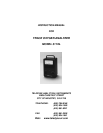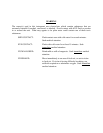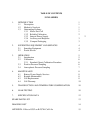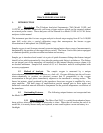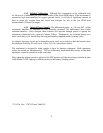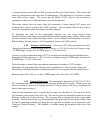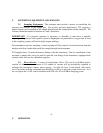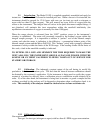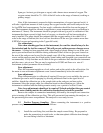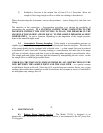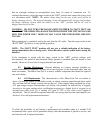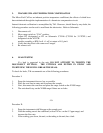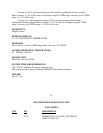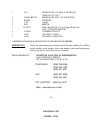
Span gas: An inert gas (nitrogen or argon) with a known trace amount of oxygen. The
oxygen content should be 70 – 90% of the full scale on the range of interest (working or
primary range).
Note, if this instrument is exposed to high concentrations of oxygen (percent levels), it
will take a significant amount of time to purge the oxygen from the sensor and analyzer for use
for low PPM level measurements. For best results, calibration should be done on the range of
use. The instrument should be allowed to equilibrate to room temperature prior to calibration (a
minimum of 3 hours). The instrument should be purged with zero gas prior to calibration if the
instrument has been exposed to high levels of oxygen, or when the cell has been replaced or
newly installed. The purge should be continued until the oxygen reading is less than 10% of
scale on the range of interest (this level will not be achieved if the zero gas contains more than
0.2PPM of oxygen and operating in the 2 ppm full scale).
Gas connections.
Note when attaching gas lines to the instrument, the vent line should always be the
first attached and the last line removed. This will prevent sudden pressure changes across
the sensor. A fitting has been supplied with a short length of plastic tubing for use in the vent
port to prevent backward air diffusion during calibration. Ether of the two gas ports located on
the rear of the analyzer can be used for the sample vent. All of the connections between the gas
source and the analyzer must be of high quality (metal tubing and Swagelok type connections are
recommended). Verify that there are no leaks in the gas connection lines between the instrument
and the source prior to use. The gas may be regulated at 5 PSIG and flown at a rate of 1
liter/minute (control parameters are not critical).
Zero adjustment.
Place the instrument upright on a level surface and set the switch to the off position. Set
the meter to zero with meter adjustment screw located immediately below the meter dial.
Span adjustment.
Purge instrument prior to calibration if required. If zero gas is not available, the span or
calibration gas can be used for purging by allowing additional time for the signal level to
stabilize. Attach the calibration gas to the sample inlet on the analyzer, and turn on the
instrument. Select the proper range for calibration based on the calibration gas. Allow the
instrument to stabilize until the reading remains steady over a period of at least 10 min.
Note: large adjustments should not be required! Unlock and adjust the span control
until the meter reading matches the calibration standard and re-lock the span dial.
Remove the sample–in connection immediately followed by the sample-vent connection
prior to turning off the calibration gas flow. This will prevent air from entering the analyzer, or
the pressurizing the sensor compartment. The analyzer is now ready for use.
3.3 Positive Pressure Sampling. When connecting the instrument to a positive
pressure sample source, ALWAYS proceed as follows:
-6-
1) Install the vent fitting first, and then the sample source fitting. Be prepared to
make the connections in rapid order, so that atmospheric diffusion time through
the vent fitting is held to a minimum.



